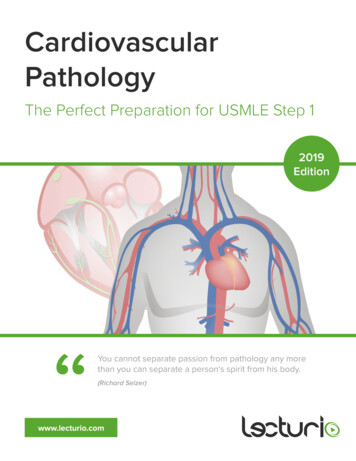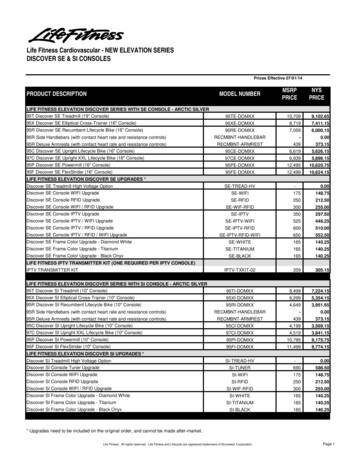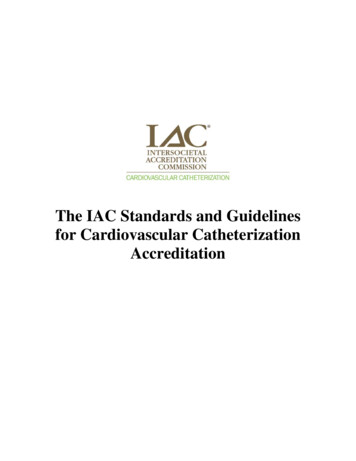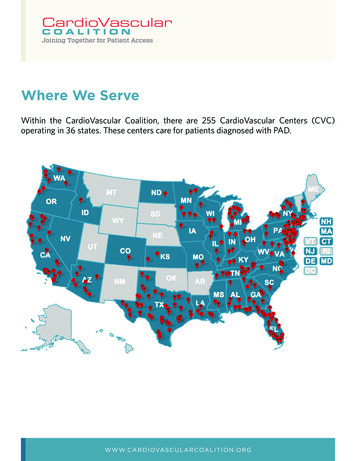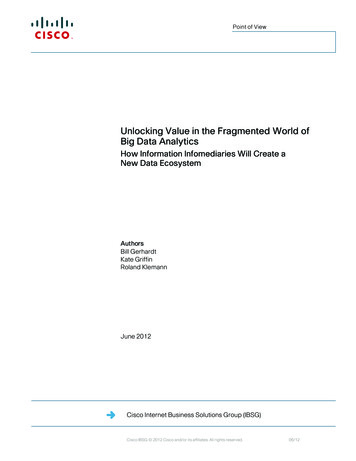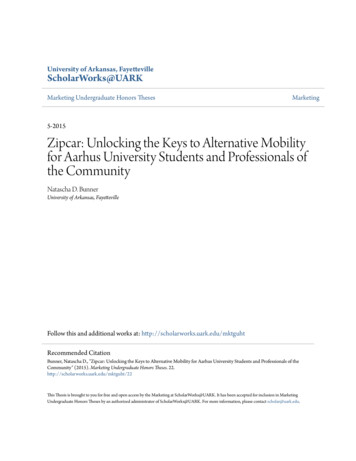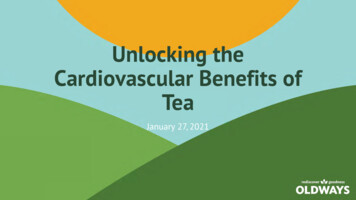
Transcription
Unlocking theCardiovascular Benefits ofTeaJanuary 27, 2021
About Oldways Nutrition nonprofitfounded in 1990 Mission: To inspire peopleto embrace the healthyand sustainable joys of theold ways of cooking andeating Visit us online atoldwayspt.org
Housekeeping Attendees will receive an email within ONE WEEK with CPEUcertificate, slides, and recording Visit oldwayspt.org and click on “CPEU Library” in the top-rightcorner to register for upcoming webinars or view recordings ofprevious webinars Please submit any questions using the CHAT function in Zoom
Today’s SpeakersAlex WhiteJoy Dubost,PhD, RD, LDTaylor C. Wallace,PhD, CFS, FACN
Unlocking the CardiovascularBenefits of Unsweetened TeaUnileverAlex WhiteJoy Dubost PhD comAlex.white.teajoyofnutrition
TEA: No Other Beverage is so Deeply Rooted in theHistorical Heritage and Social Fabric of Humanity2
The rituals: More than just a drink, different tea traditions are now famous aroundits preparation, presentation, and consumption and are deeply rooted in manyworld cultures.
What is tea?There are two broad categories:True TeaTisanes & Non-Tea Made with leaves of the C. Sinensis plant Two main varieties of the C. Sinensis plant exist:var.assamica and var. sinensis Thousands of different cultivars4 Made from flowers, herbs and plants other than C.Sinensis Offer distinct flavors & some are thought to havemedicinal propertiesBlack TeaGreen TeaChamomileMintWhite TeaOolong TeaMateRooibos
TEA FACTS.Most Widely Consumed Beverage inThe World Next to Water60 Billion Servings of Tea,Over 2.8 Billion Gallons*On any given day,127 Million peoplein USA drink Tea70% of TeaConsumed inAmerica is ICED
LOVES: Well drained acid soil Proximity to the equator Lots of rain Clean air Sun1YrHATES: Soggy soil Alkali soil The R&D Lab2-3YrThe Camellia Sinensis is just one plant generating all teas(black, green,white, yellow, oolong, pu-her, Matcha, etc.).Farmed as a bush for easy harvest,it will grow into a tree in the wild.20-30Yr?Yr
R&DGreenhouseNew JerseyTea propagation is achieved either from seed or fromcuttingsCUTTINGS:Pros:One of the main reasons to take cuttings isthat they are identical to the mother plant andcan replicate their most vigorous, high yieldingplants over and over again.Cons: Problems can arise with fighting offenvironmental stresses, diseases and insects, asthe genetics somewhat weaken.SEEDS:Pros: More biodiversity,growing from seedlessens the chances ofinheriting any pests ordiseases from a cutting.Cons: germination rates vary by plant species, harvest times arelonger than when starting from cuttings, and sometimes there arecosts associated with purchasing them (whereas clones taken fromplants are free).
One Plant, many types of tea Owing their definitive differences to: Where they are grown How they are picked How they are processedMAIN TEA TYPES:FLAVORED TEA:ChaiWhiteGreenOolongBlackPu ErhMatchaEarl GreyJasmine tea
WHERE DOES TEA COME FROM (and why does it matter?)Tea estates are often nestled in beautiful pristine preservedenvironments, where soil properties, altitude, latitude, or even proximityto other vegetation, will impart the tea with a pure distinctive signaturecharacter, un-replicable anywhere else. Tea tasters call it “origincharacter”; it is essentially the passing on of those territories andenvironment into the tealeaf itself.
Where true tea is grownArgentinaKenyaWorld production approx. 5M tons
Tea Growing Elevations8,000 ftDarjeelingHigh GrownKenya, Rwanda &BurundiTanzania & UgandaSriLankaIndonesiaMalawi,ZimbabweArgentinaSea LevelNorth India,Vietnam &BangladeshLow GrownBody, Colour4,000 ftMedium GrownFlavor, AromaSouth India (Nilgiris Hills, Munnar)
WHAT DOES EACH PROVENIENCEBRING TO THE TEA?AN EXAMPLE FROM A TYPICAL ICED TEA BLENDTASTEArgentinaMellowness, Clarity and sparkleMalawiColor, deep red huesKenyaTaste, “Briskyness”COLORBITTERNESS
HOW IS TEA HARVESTED?Tea Plucking is together hard work and a skill. Whether by hand or by machine, tea needs to beselectively plucked from an emerging flush, to give the desired results in the blend.
Tea Processing in factories is done in the immediate proximity of the field to maintainthe leaf as fresh and intact as possible and occurs within 24h of picking. The process isreally a craft, requiring nothing more than experience, air and heat.
Tea processing flow diagram
CTC process from field to pack in less than 24hTRANSPORT16RECEPTIONROTOVANEPepsi Lipton ConfidentialWITHERINGCTC
OXIDATION (about 2h)17DRYINGFIBRE EXTRACTION
And finally grading to sort the quality leavesSIEVINGGRADINGQUALITY CTRLCUPPINGDISPATCHING
Once made the Tea samples are lined up for auction. Thousands of cups are tasted and gradedbefore each auction by tea tasters through a steamy and hectic ritual of slurping and spitting sothat they may instruct the auctioneers and select the best.
Sustainability in TeaEconomic FocusProviding jobs and paying a premiumprice for teaSocial FocusProviding workers & families with housing,medical care, clean waterEnvironmental FocusConserving Biodiversity, Protecting soilsand waterways20
Rainforest Alliance 700K estates 2.7Mio acres 99 evaluation criteriaRA COVERS ALL THREE SUSTAINABILITY PILLARSENVIRONMENTAL PROTECTIONSOCIAL EQUITYECONOMIC VIABILITY
EMERGING TRENDS IN TEAOrganicCold BrewMatchaNew unconventional origins: Australia, U.S., Colombia, etcHealth-led benefitsCheese teas/ Boba /Lattes at home café experienceNew cultivars: Purple teaCult teas: Pu-her, HeiCha, Kukicha, HojichaTea and food: food pairings, cooking with tea
Tea - Health andNutrition
TEA FACTSMost Widely Consumed Beveragein The World Next to Water60 Billion Servings of Tea,Over 2.8 Billion GallonsNaturally contains: Caffeine (28 -47mg/8 oz ) - USDA Theanine (20mg/8 oz) Flavonoids (levels vary)
FLAVONOIDSWhat are Flavonoids? Naturally occurring polyphenolic compounds Flavonoids refer to a collective term that includes six groups -ols,anthocyanidins, isoflavones Flavonoids are present in fruits, vegetables, and certain beverages Sources of flavonoids include tea, apples, grapes, red wine andcocoa
TEA CONTAINS FLAVONOIDS Tea is one of the top sources of flavonoids in the diet Flavonoids are responsible for key sensory attributes of tea –color, taste, and astringency Flavonoids in tea can be absorbed into the body regardless ofwhether or not milk is added (up to 25% of milk added)Common Food Sources ofFlavan-3-ols (Catechins)140mg/100 g120100806040200Flavan-3-olsUSDA database, 2011
CARDIOVASCULAR DISEASE Refers to a number of conditions: Heart and Blood Vessel Disease (Heart Disease) Heart Attack Stroke Prevalence* Heart Disease remains the No. 1 cause of death in the U.S. 48% of all adults in the U.S. have some form of cardiovascular disease Cardiovascular disease, listed as the underlying cause of death, accounts for nearly 837,000deaths in the US. That’s about 1 of every 3 deaths in the U.S. Direct and indirect costs of total cardiovascular diseases and stroke are estimated to totalmore than 329.7 billion; that includes both health expenditures and lost productivity. Cardiovascular disease is the leading global cause of death, accounting for more than 17.9million deaths per year in 2015, a number that is expected to grow to more than 23.6 millionby 2030.*American Heart Association
INCREASED CONSUMPTION OF FLAVONOIDS FROM ALL DIETARYSOURCES IS ASSOCIATED WITH A LOWER RISK OF CVDCompared with lowerintake, high consumption oftotal flavonoids wasassociated with decreasedrisk of all-causemortality (RR 0.74,), whilea 100-mg/day increment inintake led to a (linear)decreased risk of 6% and4% of all-cause and CVDmortality, respectively1Higher dietary flavonoidintake is associated witha significantly reducedrisk of stroke.Dose-response analysesindicated a 9% lower riskof stroke per 100 mg/dayincrement in flavonoids.21GrossoAm J Epidemiol. 2017;185(12):1304–13162Tang Z, et al. BMJ Open (2016) 6:e008680
CAN HELP SUPPORT A HEALTHY HEART A substantial amount of consistent scientific evidence demonstrates aninverse relationship between overall flavonoid consumption and at least oneor more cardiovascular endpoints. Front of Pack Claim - “Can Help Support a Healthy Heart” Back of Pack Claim – Daily consumption of 2-3 cups of unsweetenedbrewed tea providing between 200-500mg of flavonoids can help support ahealthy heart as part of a diet consistent with dietary guidelines. One cup of Lipton brewed green and black tea provide 150 and 170 mgflavonoid, respectively Zero Calories No added sugar Flavonoid content can range among tea products
Do unsweetened tea drinkers have healthier diets? The results indicated the diets of daily consumers of unsweetenedtea are significantly higher in protein, dietary fiber, and selectvitamins and minerals, but lower in added sugars and alcohol. Daily unsweetened tea consumption is associated with highergood cholesterol (HDL) and lower body mass index (BMI) values(lower body weight) in adults. Relative to those who do not consume tea, unsweetened teaconsumers generally have healthier beverage choices, includingless high calorie sugar sweetened beverages.30
2020-2025 DIETARY GUIDELINES FOR AMERICANS When choosing beverages in a healthy dietarypattern, both the calories and nutrients theyprovide are important considerations.
CONCLUSIONS Unsweetened tea (green or black, hot or cold) may beconsidered a primary beverage option as noted in theUSDA 2020-2025 Dietary Guidelines for Americans Scientific evidence illustrates an inverse linear doseresponse relationship between consumption offlavonoids and all-cause and CVD mortality Tea is a great option for hydration & can help supporta healthy heartFor additional resources -health/32
THANK YOU
The CardiovascularBenefits of Black andGreen TeaTaylor C. Wallace, PhDThink Healthy GroupGeorge Mason University
DisclosuresA few conflicts of interest related to the presentation up front: Think Healthy Group George Mason University Journal of Dietary Supplements Journal of the American College of Nutrition Annals of Medicine Research funding from Unilever (owns Lipton ) www.drtaylorwallace.com 2020 Dr. Taylor Wallace.07-21-20202
Tea (Camellia sinensis)A little background on tea: Tea is a beverage commonly prepared by pouring hot water overfermented or fresh leaves of the plant Camellia sinensis. Second most widely consumed beverage in the world, next towater. Consumption documented as early as the 3rd century AD inmedical texts written by Chinese physician, Hua Tuo. The plant is native to East Asia and likely originated in theborderlands of north Burma and southwestern China.Nutrition Today. 2018;53(5):213. 2020 Dr. Taylor Wallace.05-07-20203
Medicinal Aspects of TeaTea has been used in traditional eastern medicine for centuries Tea drinking is popular in traditional Chinese medicine.It is alsobelieved that the people of Sichuan used the brewed tea as astimulating beverage, rather than a medicinal concoction. Tea is a major source of flavonoids in the diet.American teadrinkers have been shown to have 20 times higher flavonoidintakes compared to those who do not consume tea.J Nutr. 2008;138(8):1543S. 2020 Dr. Taylor Wallace.05-07-20204
Flavonoids & Flavan-3-olsWhat are flavonoids and flavanols? Flavonoids are healthy polyphenolic compounds foundin plant-derived foods. There are six groups offlavonoids and each is broken down by the body in adifferent way: flavonols, flavanols, flavones,flavanones, anthocyanins, and isoflavones.Structure of a flavanol. Flavanols (also known as flavan-3-ols) in products liketea, cocoa, and cranberry have an abundance researchdemonstrating their potential heart-health effects.Am J Clin Nutr. 2019;110(5):1067. 2020 Dr. Taylor Wallace.05-07-20205
Tea Consumption and CVDWhat’s all the fuss about tea and CVD? 48% of adults in the United States have some form ofcardiovascular disease (CVD) according to the AmericanHeart Association. Consumers describe cardiovascular health as a top desiredbenefit from food. Consumers prefer to be told what to eat vs. what not toeat. Therefore, tea consumption may be a practical meansof preventing the onset of CVD, the leading cause of deathamong ds/2018/05/2018-FHS-Report-FINAL.pdf 2020 Dr. Taylor Wallace.05-07-20206
Our ResearchSystematic reviews of the entire body of research: First systematic review assessed the role of tea consumption inrelation to all cause mortality, CVD mortality, CVD events (e.g.,heart attack), and stroke events. Second systematic review assessed the role of tea consumptionin relation to blood lipids (i.e., total cholesterol, LDL-cholesterol,HDL-cholesterol, and triglycerides) and blood pressure. We used the National Academies of Medicine’s standards forconducting systematic reviews.Finding what works in health care: standards for systematic reviews. National Academies Press; 2011. 2020 Dr. Taylor Wallace.05-07-20207
Systematic Review (SR) 1Results: 39 prospective cohort studies included in the systematic review: all cause mortality(N 15), CVD mortality (N 19), CVD-events (N 7), and stroke events (N 13). Most studies reported multiple outcomes of interest.data to be included in our meta-analyses.8 studies did not report sufficient Each cup of daily tea consumption was associated with an average 1.5% lower risk of allcause mortality, 4% lower risk of CVD mortality, 2% lower risk of CVD events, and 4%lower risk of stoke events.Adv Nutr. 2020.;11(4): 790. 2020 Dr. Taylor Wallace.05-07-20208
SR 1 – Results – All Cause MortalityNoAdjustedoutcome at AdequateTeaFollowupRegiontype(yr)IncidenceRR (95% CI)adultsUSAblack50.007270.97 (0.94, 1.00)CadultsUSAblack80.004360.98 (0.96, 1.00)CKuriyama et al. 2006 (39)adultsAsiagreen110.011420.97 (0.95, 0.98)de Koning et al. 2010 (26)adultsEuropeblack130.00349Yan et al. 2017 (58)adultsUSAblack16Odegaard et al. 2015 (50)adultsAsiagreenSuzuki et al. 2009 (54)elderlyAsiaLim et al. 2017 (44)Gardener et al. 2013 (28)StudyAge(Reference)groupKlatsky et al. 1990 (36)Klatsky et al. 1993 (37)Exposure ComparabilitystartfollowupABABABAABABAB1.01 (0.98, 1.05)AABAB0.094491.01 (0.92, 1.10)CABAB16.30.1990.99 (0.96, 1.02)BABAAgreen5.20.193150.93 (0.90, 0.95)CBBCelderlyAustralia black100.034310.90 (0.81, 0.99)CABBelderlyUSAblack110.031880.87 (0.80, 0.95)CABAABox sexes0.97 (0.95, 0.99)Subtotal (I 2 75.6%, P 0.001)FemaleIwai et al. 2002 (34)adultsAsiagreen9.90.008070.93 (0.83, 1.04)CBBAvan den Brandt et al. 2018 (56)adultsEuropeblack100.241721.01 (0.97, 1.05)BABABAnderson et al. 2006 (22)adultsUSAblack150.01111.01 (0.99, 1.03)BABABSaito et al. 2015 (52)adultsAsiagreen18.70.090670.98 (0.96, 0.99)AABAB0.99 (0.97, 1.02)Subtotal (I 2 58.3%, P 0.066)MaleIwai et al. 2002 (34)adultsAsiagreen9.90.016980.95 (0.89, 1.02)CBBAvan den Brandt et al. 2018 (56)adultsEuropeblack100.535340.97 (0.93, 1.01)BABABLiu et al. 2016 (45)adultsAsiagreen110.198360.98 (0.97, 0.99)CABABHetog et al. 1997 (31)adultsEuropeblack140.008471.14 (1.06, 1.23)AABAASaito et al. 2015 (52)adultsAsiagreen18.70.176950.98 (0.96, 0.99)AABABSubtotal (I 2 77.8%, P 0.001)0.99 (0.96, 1.01)0.98 (0.97, 0.99)Overall (I 2 73.7%, P 0.001)0.80.911.11.2P 0.0011.3Adv Nutr. 2020.;11(4): 790. 2020 Dr. Taylor Wallace.05-07-20209
SR 1 – Results – CVD MortalityNoStudyAge(Reference)groupKuriyama et al. 2006 (39)de Koning et al. 2010 (26)outcome at RR (95% CI)adultsAsiagreen110.003980.95 (0.92, 0.98)BadultsEuropeblack130.000450.93 (0.84, 1.04)AYan et al. 2017 (58)adultsUSAblack160.026151.00 (0.84, 1.18)Odegaard et al. 2015 (50)adultsAsiagreen16.30.06104Suzuki et al. 2009 (54)elderly Asiagreen5.2Lim et al. 2017 (44)elderly Australia blackGardener et al. 2013 (28)elderly USAblackstartfollowupABABABABCABAB0.99 (0.93, 1.04)BABAA0.077880.86 (0.82, 0.90)CBBC100.013460.92 (0.86, 0.98)CABB110.012630.95 (0.84, 1.08)CABAAExposure ComparabilityBoth sexesSubtotal (I 2 62.9%, P 0.013)0.93 (0.89, 0.97)FemaleWoodward et al. 1999 (57)adultsEuropeblack7.70.000950.98 (0.82, 1.17)CABAAvan den Brandt et al. 2018 (56)adultsEuropeblack100.081461.04 (0.99, 1.10)BABABMineharu et al. 2011 (48)adultsAsiagreen13.10.002930.93 (0.89, 0.98)AABAAAnderson et al. 2006 (22)adultsUSAblack150.003671.00 (0.96, 1.03)BABABSaito et al. 2015 (52)adultsAsiagreen18.70.011990.92 (0.87, 0.97)AABABSubtotal (I 2 72.0%, P 0.006)0.97 (0.93, 1.02)MaleWoodward et al. 1999 (57)adultsEuropeblack7.70.002420.93 (0.84, 1.03)CABAAvan den Brandt et al. 2018 (56)adultsEuropeblack100.188670.95 (0.91, 1.00)BABABLiu et al. 2016 (45)adultsAsiagreen110.072770.97 (0.96, 0.98)CABABMineharu et al. 2011 (48)adultsAsiagreen13.10.004391.04 (0.99, 1.08)AABAAHetog et al. 1997 (31)adultsEuropeblack140.002911.14 (1.01, 1.29)AABAASaito et al. 2015 (52)adultsAsiagreen18.70.023430.96 (0.93, 1.00)AABABHetog et al. 1993 (30)elderly Europeblack50.015670.63 (0.45, 0.90)AABAASubtotal (I 2 72.5%, P 0.001)0.98 (0.94, 1.02)Overall (I 2 72.4%, P 0.001)0.96 (0.94, 0.98)0.60.70.80.911.1P 0.0011.2Adv Nutr. 2020.;11(4): 790. 2020 Dr. Taylor Wallace.05-07-202010
SR 1 – Results – CVD EventsStudy(Reference)AdjustedRR (95% CI)Followup(year) IncidenceNooutcome at AdequateExposure ComparabilitystartfollowupAgegroupTeaRegion typeGaeini et al. 2019 (27)adultsIranblack60.005561.04 (1.01, 1.08)BABACLi et al. 2017 (43)adultsAsiaall7.20.008360.99 (0.98, 0.99)BABABMiller et al. 2017 (47)adultsUSAall11.10.011650.83 (0.69, 1.00)BABADBoth sexesde Koning et al. 2010 (26) adultsEurope black130.004040.96 (0.93, 0.99)AABABKokubo et al. 2013 (38)adultsAsiagreen130.004680.97 (0.95, 0.98)BABABSesso et al. 2003 (53)adultsUSAblack150.003320.98 (0.96, 1.01)CABAAEurope black5.60.007320.75 (0.57, 0.98)BABABGeleijnse et al. 2002 (29) elderly0.98 (0.96, 1.00)Overall (I2 76.5%, P 0.001)0.60.70.80.911.1P 0.0851.2Adv Nutr. 2020.;11(4): 790. 2020 Dr. Taylor Wallace.05-07-202011
SR 1 – Results – Stroke EventsNoStudyAgeTeaFollowupAdjustedoutcome at Adequategroup Region type(year)IncidenceRR (95% CI)Tanabe et al. 2008 (55)adults Asia50.005150.85 (0.77, 0.93)CBABLarsson et al. 2013 (40)adults Europe black10.20.005810.99 (0.95, 1.02)BABABKuriyama et al. 2006 (39)adults Asiagreen110.001490.92 (0.88, 0.97)BABABde Koning et al. 2010 26)adults Europe black130.001471.02 (0.97, 1.07)AABABKokubo et al. 2013 (38)adults Asiagreen130.003710.96 (0.94, 0.97)BABABKeli et al.1996 (35)adults Europe black150.007780.52 (0.31, 0.86)AABAASesso et al. 2003 (53)adults USA150.000780.98 (0.92, 1.05)CABAA(Reference)Exposure ComparabilitystartfollowupBoth sexesSubtotal(I 2greenblack 74.3%, P 0.001)0.96 (0.92, 0.99)FemaleLeurs et al. 2010 (42)adults Europe black100.014531.00 (0.90, 1.12)BABABMineharu et al. 2011 (48)adults Asiagreen13.10.001220.94 (0.86, 1.01)AABAALopez Garcia et al. 2009 (46)adults USAblack240.00120.95 (0.89, 1.02)AABAA2Subtotal (I 0.0%, P 0.596)0.96 (0.91, 1.00)MaleLeurs et al. 2010 (42)adults Europe black100.022610.99 (0.90, 1.08)BABABMineharu et al. 2011 (48)adults Asiagreen13.10.001831.04 (0.96, 1.12)AABAALarsson et al. 2008 (40)adults Europe black13.60.007640.91 (0.86, 0.96)BBAASubtotal (I 2 77.1%, P 0.013)0.97 (0.89, 1.06)Overall (I 2 63.9%, P 0.001)0.96 (0.93, 0.99)0.40.50.60.70.80.91P 0.0021.1 1.2Adv Nutr. 2020.;11(4): 790. 2020 Dr. Taylor Wallace.05-07-202012
Systematic Review (SR) 1Strength of Evidence Grading Based on the evidence-to-date. Single components of the diet are likely to showonly minute effects. Dietary patterns (e.g., consuming tea along witha healthy diet rich in fruits, vegetables, wholegrains, lean protein, and low/non-fat dairy)show much larger effects. Its hard to tease out confounders inOutcomeAll Cause MortalityAdultsElderly ( 65)CVD MortalityAdultsElderly ( 65)CVD EventsStroke EventsStrength of EvidenceLowLowLowModerateLowLowobservational studies.Adv Nutr. 2020.;11(4): 790. 2020 Dr. Taylor Wallace.05-07-202013
Why Does Tea Decrease Risk of CVD?Let’s talk mechanisms: Tea may influence multiple biological processes that impactdevelopment of CVD, including but not limited to effects on: Blood lipids MicrobiomeBlood pressureEndothelial function and improvements in blood flowCross-communicating proteins that regulateinflammationJ Nutr. 2020.;150: 3269. 2020 Dr. Taylor Wallace.05-07-202014
Systematic Review (SR) 2Results: 14 randomized controlled trials included in the systematic review: total cholesterol (N ),LDL-cholesterol (N ), HDL-cholesterol (N ), triglycerides (N ), systolic blood pressure (N ),and diastolic blood pressure (N ). Most studies reported multiple outcomes of interest and had insufficient sample sizes andstatistical power to to observe changes. No significant effects of tea consumption were found on total cholesterol, LDL-cholesterol,HDL-cholesterol, triglycerides, systolic blood pressure, and diastolic blood pressure.J Nutr. 2020.;150: 3269. 2020 Dr. Taylor Wallace.05-07-202015
SR 2 – Results – Blood LipidsJ Nutr. 2020.;150: 3269. 2020 Dr. Taylor Wallace.05-07-202016
SR 2 – Results – Blood PressureJ Nutr. 2020.;150: 3269. 2020 Dr. Taylor Wallace.05-07-202017
Endothelial Function & Blood FlowDilation of the arteries Endothelial cells line the inside of the arteries (known as the endothelium) and produceendothelial nitric oxide (eNOS) in response to flavanols and other healthy dietarycomponents. eNOS dilates the arteries and helps to promote healthy blood flow. This isbiological process is termed “flow-mediated dilation” or FMD. Tea consumption has been shown in a recent systematic review to improve FMD by about2.6%. Just a 1% change in FMD has been shown to reduce the risk of CVD by 10%Int J Cardiol. 2013;168:344. 2020 Dr. Taylor Wallace.05-07-202018
InflammationRegulation of cross-communicating proteins. Inflammation refers to the body’s process of fighting thingsoff that harm it. When something damages your cells,cross-communicating proteins trigger a response from theimmune system. Flavonoids are known to positivelyinfluence CVD risk by acting on these cross-communicatingproteins that regulate the anti-inflammatory Nrf2 andproinflammatory nuclear factor-Κβ (NF-Κβ) pathways.Compr Rev Food Sci Food Saf. 2018;17:1054. 2020 Dr. Taylor Wallace.05-07-202019
Effects On The MicrobiomeColonic microbes convert flavanols The microbiome is known to metabolizeflavanols efficiently into small-molecularweight compounds that exert biologicaleffects in relation to CVD and p.Lactobacillus spp.B. coagulansS. thermophilusE. coliC.difficileS. aureusSalmonella spp. At the same time, a diet rich in foodscontaining flavonoids has been shown topromote the growth of probiotic bacteria.Nutr Today. 2018;53(5):213. 2020 Dr. Taylor Wallace.05-07-202020
Effects On The MicrobiomeBiosci Microbiota Food Health. 2014;33(3):99. 2020 Dr. Taylor Wallace.05-07-202021
ConclusionConclusion: Unsweet tea consumption seemsto decrease the incidence ofCVD-related mortality andevents, but the biologicalmechanisms are likelymultifactorial and still underinvestigation.J. Nutr. 2020.;150: 3269. 2020 Dr. Taylor Wallace.05-07-202022
Thank You!PhD, CFS, FACNThink Healthy GroupGeorge Mason UniversityEmail: drtaylorwallace@gmail.comWebsite: www.DrTaylorWallace.comText FOOD to 202-410-4202 to join my email list.@DrTaylorWallace 2020 Dr. Taylor Wallace.05-07-202023
Back of Pack Claim –Daily consumption of 2-3 cups of unsweetened brewed tea providing between 200-500mg of flavonoids can help support a healthy heart as part of a diet consistent with dietary guidelines. One cup of Lipton brewed green and black tea provide 150 and 170 mg

